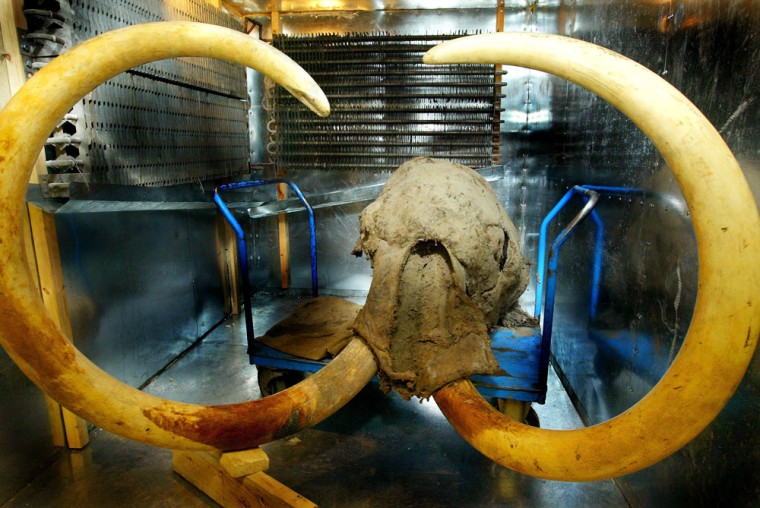Shuttle buses without drivers, trains floating on magnetic fields and other visions of the future will be on display at Japan's world fair next year. But the centerpiece at Expo 2005 will be rooted deep in the past — the frozen remains of a woolly mammoth.
The beast's nearly intact head, tusks and a front leg were excavated from the Siberian tundra in June, and Expo organizers plan to put them on display in a laboratory with a gallery so visitors can watch as scientists conduct tests.
"We want people to look at the future by starting with a perspective of the past," says Naoki Suzuki, the Japanese scientist overseeing the exhibit, which goes on display next March outside Nagoya, nearly 170 miles (270 kilometers) west of Tokyo.
For visitors, one of the biggest thrills will be viewing what experts say is the most intact mammoth head recovered in centuries.
Scientists, meanwhile, hope the preserved remains will yield clues to one of the great mysteries about woolly mammoths: why they became extinct 10,000 years ago.
3-D map of a mammoth's brain
Researchers armed with a subfreezing lab and state-of-the-art equipment plan to use advanced X-ray technology to peer inside the mammoth's head by generating a 3-D map of its brain.
They will also examine muscle tissue to figure out how mammoths walked; study rocks, pollen and plants caught in the animal's fur and at the excavation site; cut into the tusks to determine the animal's age, what it ate and whether it was ill; and look for DNA in tissue to answer questions about disease and viruses.
"We can reconstruct details of the animal's life, such as its diet, its health history and the climate it encountered," says Daniel Fisher, a curator at the University of Michigan's Museum of Paleontology who is in charge of analyzing the tusks.
Mammoths first appeared in Africa as much as 4 million years ago, and they roamed the plains of Siberia for nearly 2 million years before suddenly dying off 10 millennia ago. Scientists remain divided over the cause of the mammoths' extinction, with theories pointing at human hunters, a killer disease or climate change.
Close to a perfect specimen
For more than two centuries, mammoth remains have been turning up in the Russian tundra above the Arctic Circle. The Expo's mammoth was excavated north of the town of Yakutsk, about 3,100 miles (5,000 kilometers) east of Moscow.
Until now, crude technologies have thwarted scientists' attempts to salvage soft tissue that might tell more about the giant beasts. Paleontologists normally thaw frozen mammoth remains with hair dryers, which can destroy muscle, organs and skin, leaving a parched fossil.
Doing that to the Expo mammoth might squander a rare opportunity.
When researchers excavated the remains, they were astonished to find an entire head, wrapped in skin and hair and with both tusks. An attached ear and eyelid made it appear "as if it had just fallen asleep," says Suzuki, a paleontologist and computer-imaging expert at Jikei University in Tokyo.
"It's the closest to a perfect specimen of a mammoth's head we have seen in the last 200 years," he says.
Though little of the mammoth's hindsection remained, the scientists found its right front leg with flesh and joints. Bones from its shoulder, back and ribcage were scattered nearby.
Keeping it frozen
Working with Dutch paleontologist Dick Mol, French Arctic explorer Bernard Buiges, Alexei Tikhonov of Russia's Zoological Institute and other mammoth experts, Suzuki wants to keep the mammoth frozen for experiments and avoid slicing it up.
"Nowadays, you can view internal body parts without cutting anything," he says.
Instead of dissection, they will rely on X-ray scans, powerful computers with 3-D technology and minimally invasive surgical techniques normally used on humans.
Much is still unanswered about the project, including how much of Expo's $2.7 billion budget will go to the mammoth exhibit. The remains are still in Russia, and it's uncertain when they will arrive.
Ross MacPhee, a curator at New York's American Museum of Natural History who is on the research team, says the head scans could show blood vessels, nerves and other brain tissue that are difficult to dissect.
Though computer images are no substitute for actual tissue, they may help paleontologists settle a dispute about whether mammoths and elephants are family members or cousins, MacPhee says.
But he cautions that the tissues may be dried out after millennia of lying in ice.
If there is no moisture left, "keeping (the mammoth) frozen while scanning will retard mold formation but it will not enhance structure," MacPhee says.
